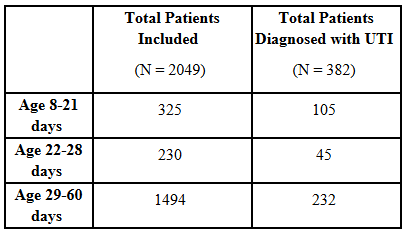Hospital Medicine 5: Clinical
Session: Hospital Medicine 5: Clinical
521 - Accuracy of UA Components in Detecting UTI in Febrile Neonates by Age Sub-Group Analysis
Sunday, April 27, 2025
8:30am - 10:45am HST
Publication Number: 521.3733
Jennifer Stamp, Phoenix Children's Hospital, Phoenix, AZ, United States; Jared Kusma, Phoenix Children's, Phoenix, AZ, United States; Maheshwor Kafle, Phoenix children’s hospital, Phoenix, AZ, United States; Richard Engel, Phoenix Children's Hospital, Phoenix, AZ, United States; Jillian Wall, Phoenix Children's Hospital, Phoenix, AZ, United States; Quinney Fu, Phoenix Children's, Phoenix, AZ, United States; Jacob Phouthavong-Murphy, Phoenix Children's Hospital, Tempe, AZ, United States; Ashley Bartlett, Phoenix Children's Hospital, Scottsdale, AZ, United States; Sandra Gage, Phoenix Children's Hospital, Racine, WI, United States
- JS
Jennifer T. Stamp, MD (she/her/hers)
Resident
Phoenix Children's Hospital
Phoenix, Arizona, United States
Presenting Author(s)
Background: Urinary tract infections (UTIs) are the most common bacterial infection (BI) in infants. Urinalysis (UA) is a common screening tool for UTI, but there is limited consensus on the accuracy of its components in febrile infants 8-60 days old. Sensitivities in literature range from 48-99% and specificities from 88-98%. No recent studies have evaluated UA components by the age groups outlined by the American Academy of Pediatrics clinical practice guideline for febrile infants.
Objective: Evaluate and compare the accuracy of UA components in detecting UTI in febrile infants 8-21, 22-28 and 29-60 days old.
Design/Methods: Retrospective cohort study of infants 8-60 days-old with objective fever ≥38°C seen at a tertiary care center from 1/1/2018-12/31/2023. Patients were identified using ICD-10 codes for fever/BI. Exclusion criteria: prematurity ( < 37 weeks), previous intensive care stay, prior antibiotic use, complex care needs, unknown UA results, or known source of fever that was not a UTI, bacteremia or meningitis. Data Collected: catheterized UA and urine culture. UA components assessed: leukocyte esterase (LE), nitrites (N) and white blood cells (WBC). UA was considered positive if WBC>5/hpf, N positive, or LE positive. UTI was defined as urine culture growth, treating clinician considered it a true infection, and the patient was adequately treated. Sensitivity and specificity were calculated and compared using Chi-square test (p-value < 0.05).
Results: Of the 3682 infants identified, 2049 remained after exclusions. 382 were UTI+ (Table 1). LE was most sensitive for UTI in 8–21 day-olds vs. 22-28 and 29-60 day-olds and more sensitive in 22–28 day-olds vs 29–60 day-olds. N and WBC were more sensitive in 8–21 day-olds vs. 22-28 and 29-60 day-olds. No difference in N or WBC sensitivity was seen in 22-28 vs. 29-60 day-olds (Table 2). Specificity did not differ across age groups for any UA component (Table 3).
Conclusion(s): This study shows UA components are highly specific across all three age groups, suggesting clinicians should suspect UTI if any component is positive. UA components were most sensitive in the youngest age group, offering reassurance that UTI is unlikely to be missed in this group. A limitation of this study is that it used clinical decision making as the gold standard for UTI rather than the more widely accepted urine culture growth, which may have introduced spectrum bias. Further exploration into why sensitivity is highest in the 8–21-day age group is needed.
Demographics
 Table 1: Study Demographics
Table 1: Study DemographicsUTI- Urinary Tract Infection
Comparison of Urinalysis Components by Age Group
.png) Table 2: Comparison of Urinalysis Component Sensitivity Between 8-21, 22-28, and 29-60 Day Old Febrile Infants
Table 2: Comparison of Urinalysis Component Sensitivity Between 8-21, 22-28, and 29-60 Day Old Febrile Infants LE - Leukocyte Esterase, WBC - White Blood Cell, CI – Confidence Interval.
*Chi-Square
Comparison of Urinalysis Components by Age Group
.png) Table 3: Comparison of Urinalysis Component Specificity Between 8-21, 22-28, and 29-60 Day Old Febrile Infants
Table 3: Comparison of Urinalysis Component Specificity Between 8-21, 22-28, and 29-60 Day Old Febrile Infants LE - Leukocyte Esterase, WBC - White Blood Cell, CI – Confidence Interval.
*Chi-Square

